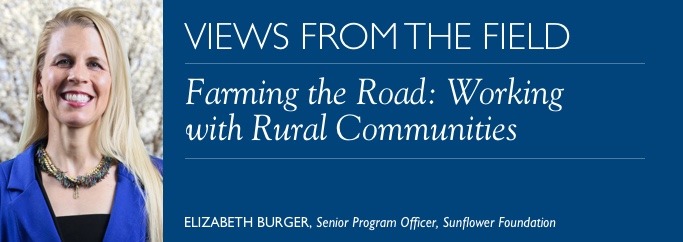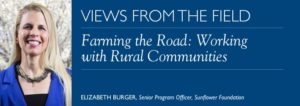
Elizabeth Burger, Senior Program Officer, Sunflower Foundation
“Farming looks mighty easy when your plow is a pencil and you’re a thousand miles from the corn field.”
– President Dwight D. Eisenhower
Eisenhower, our 34th president, came from a long history of family farming, and thus understood the complexities of agriculture–even if it appears straightforward. The same can be said for philanthropic investments to improve the health of rural America. The needs are so great, it would seem “mighty easy.” Yet, it’s anything but.
As a program officer for a statewide foundation in the Midwest, it’s exciting to see that “rural” is having its time in the spotlight. Perhaps this interest is fueled by sobering data on rural working class “deaths of despair” (Case & Deaton, 2015), or maybe recent acknowledgement that only seven percent of philanthropic dollars flow into rural areas (USDA, 2015). Whatever the reason, I’ve realized the importance of rethinking the arc of Healthy Eating, Active Living (HEAL) strategies against the realities of rural living. I hope these insights might fuel further conversation on the challenges and opportunities of building authentic rural partnerships.
Meet your partners where they’re at… literally. With rural partners, making the drive to visit their town engenders trust like nothing else. Usually, the burden is on rural partners to carve out time and expenses to make long drives for trainings and conferences in urban centers. Going to them speaks volumes about your respect for their time and your genuine desire to see their community improve. Coming from a more urban setting, it will also help you understand why their starting point, in terms of HEAL strategies, might be different from what you would expect.
Rural towns’ focus on survival supersedes all other needs. The short-term survival mentality of rural communities can be easily overlooked by those living in cities where public works and municipal duties are carried out seamlessly through paid city staff. In most rural communities, people pay the taxes, make the decisions, and very often do the work—road and building maintenance, water access, fire and emergency medical services. Volunteer service is truly the engine of a small town, but a lean population of dedicated people can get quickly overloaded. Sometimes the problem isn’t getting the grant—it’s “who will do the work?” Furthermore, the day-to-day concerns of keeping the town afloat compete with the omnipresent threat of depopulation.
Given this context, HEAL goals might be out of sync with a rural town’s priorities. A focus on policies, systems, and environment is necessary to improve long-term health, but residents first need some proof that the town isn’t dying. This is one reason the Sunflower Trails program in Kansas has been well-received. Our foundation originally funded public trails to promote equitable opportunities for physical activity. But we’ve learned that trails can be so much more: tangible proof that someone believes in the town’s future enough to invest in permanent infrastructure. Once the trail is built—or any project accomplished—the community leader or committed resident now has enough social capital to tackle the next issue.
Goals may be the same, but language can be different. Many words familiar to a health funder mean something different in rural communities. “Equity” is what you’ve paid on your land. “Policy” means restrictions. “Giving agency” must be related to the local research extension office. The worst thing we can do is to thrust uncomfortable semantics onto partners with a sense of philanthropic paternalism. Instead, we must work diligently to identify the shared values that words represent and find a language that resonates with everyone.
Sometimes that language is an action. I can’t help but think of the dozens of rural gas stations I have visited, seeing the ubiquitous counter collection jars stuffed with cash for a resident with cancer. While donation jars are undeniably a terrible method for expanding access to care, the core value—caring for each other—is not. Some might call that jar a “Band-Aid” solution, but behind it are values worthy of respect. Acknowledging that is a starting point.
True partnership means rethinking and rightsizing funding strategies. Most rural communities do not fit an ideal grantee profile. The few local nonprofits may be focused on the town’s immediate needs (e.g., fixing the playground) rather than being sophisticated change agents. The challenge is to find the unconventional allies and respect their political parameters and timelines. Some of the biggest HEAL champions are economic development directors who see the long-term value of healthy communities. But these directors work under incredible pressures and constraints to show short-term wins in towns where survival is the primary concern.
Data also look different. Truly representative county-level data can be hard to obtain. Some populations are too small for data to be de-identified, or a single incident can skew the annual county health rankings. Furthermore, fewer points of data means a greater chance of personal connection. What might be a number on spreadsheet in a city health department is a painful reminder that your neighbor’s son committed suicide in a rural county.
Small rural towns will never feel the benefits of economies of scale, and yet the cost of doing business is the same if not often much more. Even if there is public will, a sparse population means there’s fewer public funds available. This reality has caused our foundation to rethink the criteria for matching grant dollars, with the idea that towns often have hidden talents and resources that can accelerate a project, even if those don’t fit neatly on a budget line item.
Advocacy efforts look different. Health champions in rural communities very often walk a fine line of not alienating potential partners, especially when the partnership pool is so limited. Rural grantees must constantly juggle a faraway funder’s agenda with the intimate day-to-day realities of a truly interdependent small town, where histories run deep and human nature keeps score. We need to trust that our partners know the right order of priorities and understand what activities will build public trust. A health champion in Kansas explained why partner trust and flexibility in funding are so key: “We were a health coalition, but the most important thing to the town at that time was getting the grader ditches mowed. So we made sure that got done. Then they could talk about flu shots. And then young people and smoking…” And so forth. But it started with the ditches.
Finally, I’ve learned the value of “farming the road”—an expression from my husband’s farming family, used to describe driving very slowly down a country road, checking out every inch of yours and your neighbor’s farmland. What’s changed? What’s working? Rural towns may seem simple on the surface, with progress as achingly slow as a sprout pushing through the dirt. But taking the time to farm the road allows us, as funders, to see the changes that are actually happening despite the myriad of complex sociopolitical issues. Farming the road is a mindset that closes that thousand-mile gap in the Eisenhower quote and allows funders to fully support rural communities as equal partners in the quest toward better health and brighter futures.
References
Case A., Deaton A., Rising morbidity and mortality in midlife among White non-Hispanic Americans in the 21st century. Proc Natl Acad Sci U.S.A. 2015; 112 (49).
Pender, J. Foundation Grants to Rural Areas, 2005-2010: Trends and Patterns. USDA Economic Research Service – Economic Information Bulletin, June 2015; 141.

